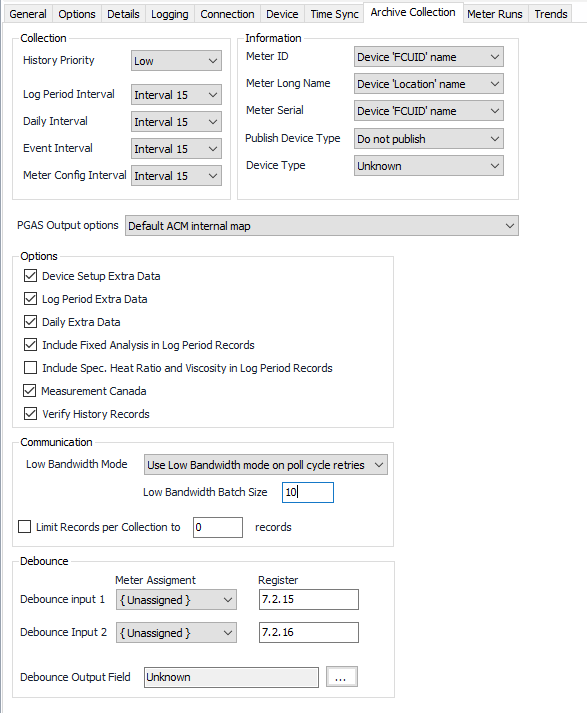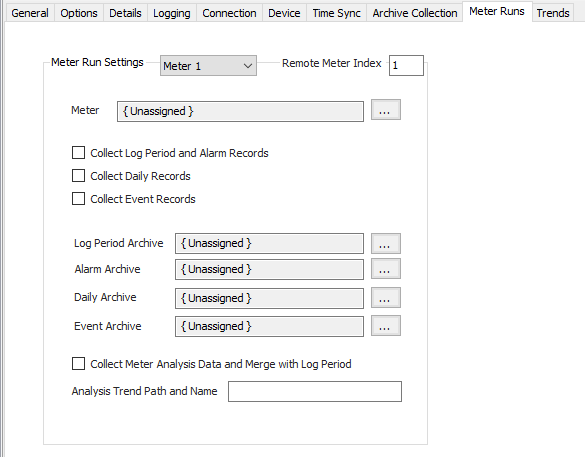| Expand | ||||
|---|---|---|---|---|
| ||||
|
...
Default = 1024. Data block size from 128, 256, 512, to 1024. Custom block size can be entered if desired.
Protocol
Newer devices use the DB2 or DB2 Compressed packet communication protocol. Older devices use a non-packetized communication protocol called DB1. The selected option will be used to communicate to the device. DB2 Compressed is the recommended setting if the device supports this feature and if history collection is performed. The compressed mode reduces the bandwidth required to retrieve history records from the field device.
...
Time Synchronization Configuration
Click to select or create the Connection Object assigned to this device. See the Time Synchronization section for more details.
Time Synchronization Interval
Select the desired Time Synchronization Interval relating to the Schedule object assigned on the Connection tab. Time Synchronization checks occur on the frequency of this interval.
Time Synchronization Priority
- Low. Queues up with other Low priority items.
- Medium (Default). Interrupts Low priority items, and queues up with other Medium priority items.
- High. Interrupts Medium and Low priority items, and queues up with other High priority items.
Timezone
Default = UTC-06:00 Central Time (US & Canada).
Archive Collection Tab
History Priority
- Low. Queues up with other Low priority items.
- Medium (Default). Interrupts Low priority items, and queues up with other Medium priority items.
- High. Interrupts Medium and Low priority items, and queues up with other High priority items.
Log Period Interval
Default = Interval 15. Select the desired Interval relating to the Schedule object assigned on the Connection tab. Log Period retrievals occur on the frequency of this interval.
Daily Interval
Default = Interval 15. Select the desired Interval relating to the Schedule object assigned on the Connection tab. Daily retrievals occur on the frequency of this interval.
Event Interval
Default = Interval 15. Select the desired Interval relating to the Schedule object assigned on the Connection tab. Event retrievals occur on the frequency of this interval.
Meter Config Interval
Default = Interval 15. Select the desired Interval relating to the Schedule object assigned on the Connection tab. Meter Config retrievals occur on the frequency of this interval.
Meter ID
Select the source for the Meter ID name. This applies only if the meter object is configured to use the protocol-specific name.
- Device 'FCUID' name (Default).
- Device 'Location' name.
- ACM device name.
Meter Long Name
Select the source for the 'meter long name' text.
- Device 'FCUID' name.
- Device 'Location' name (Default).
- ACM device name.
- ACM meter name.
- ACM meter description.
Meter Serial
Select the source for the 'meter serial number' text.
- Device 'FCUID' name (Default).
- Device 'Location' name.
- ACM device name.
- ACM meter name.
- ACM meter description.
Publish Device Type
Publish the device model name with meter configuration or history records if desired.
- Do not publish (Default).
- Publish in history.
- Publish in meter config.
Device Type
Model type of this device.
- Unknown (Default).
- XFC6200EX.
- XFC6201EX.
- mFLO6200
- XFC6300.
- XRC6400.
- NGC8200.
- PCG1000.
| Info | ||
|---|---|---|
| ||
To successfully perform a time sync command from ACM, the Device Type property must be set to 'NGC8200' on all NGC devices. No selection is necessary for other device types. |
PGAS Output Options
Default: No special mapping for PGAS output. Option1: Map Volume to Index Off and '0' to Index On.
Device Setup Extra Data
Default = Not Selected. Use the extra device setup information for EFM publishing that is available in some firmware versions.
Log Period Extra Data
Default = Not Selected. Use the extra periodic history information for EFM publishing that is available in some firmware versions.
Daily Extra Data
Default = Not Selected. Use the extra daily history information for EFM publishing that is available in some firmware versions.
Include Fixed Analysis in Log Period Records
Default = Not Selected. Include fixed analysis data in log period records when not using an analysis trend file.
Include Spec. Heat Ratio and Viscosity in Log Period Records
Default = Not Selected. Include specific heat ratio and viscosity in log period records (and meter factor for linear meters).
Measurement Canada
Default = Selected. When selected, this will use features in event and analysis data to meet the requirements of Measurement Canada.
Verify History Records
Default = Not Selected. When selected, this option will verify that the number of history records received is equal to the number of records requested. If the received number does not match the requested number, the records will be discarded and another retrieval will be attempted during a poll cycle retry, or during the next collection attempt (whether scheduled or requested). This option only applies to the 'Sequence Number' history collection method.
Low Bandwidth Mode
Low Bandwidth mode collects history using more messages with smaller content. This is available only with DB2 devices, and only when using the sequence number request method.
- Never use Low Bandwidth mode.
- Always use Low Bandwidth mode.
- Use Low Bandwidth mode on poll cycle retries (Default).
Low Bandwidth Batch Size
Default = 2. The number of records (of each history type) in each batch request while in low bandwidth mode.
Limit Records per Collection
Default = Not Selected. Specify the maximum number of history records that should be collected each retrieval cycle. Default = 0. During normal operation, this represents the maximum number of records requested for each enabled history type. In Low Bandwidth mode, this acts as the overall maximum number of records, and is checked at the end of each received batch.
Debounce input 1
Default = Unassigned. The meter number (1-20) using the specified debounce input.
Register Default = 7.2.15. The register containing the debounce configuration for the desired meter. Leave this property empty if no debounce register is used, or if reading the register is not required.
Debounce input 2
Default = Unassigned. The meter number (1-20) using the specified debounce input.
Register Default = 7.2.16. The register containing the debounce configuration for the desired meter. Leave this property empty if no debounce register is used, or if reading the register is not required.
Debounce Output Field
Default = Unknown. Click to select the identifier used by publishers to correctly place the debounce value in the output file.
Meter Runs Tab
...
Meter Run Settings - Meter
Meter 1-20. Select the meter run to configure.
Remote Meter
...
Index
Default = Meter run number (1-20). This property controls which meter in the device is retrieved for the selected ACM meter run. The default behavior is to retrieve device meter 1 for ACM meter 1, device meter 2 for ACM meter 2, etc. Use the default value for field devices with 20 or fewer meter runs.
To configure meter runs for field devices with greater than 20 meters, create an ACM device for every group of 20 meters in a single field device and set the Remote Meter Index to the appropriate meter in the field device. For example, 'Device1' meter runs 1-20 in ACM can retrieve meter runs 1-20 from the field device. Using the Remote Meter Index, 'Device2' meter runs 1-20 in ACM can be configured to retrieve meters 21-40 from the field device.
Meter
Click to select or create the Meter Object assigned to this meter run number. See the Meter section for more details.
...
Click to select or create an Archive Limits. See the Archive Limits section for more details.
Daily Archive
Click to select or create an Archive Limits. See the Archive Limits section for more details.
Event Archive
Click to select or create an Archive Limits. See the Archive Limits section for more details.
select or create an Archive Limits. See the Archive Limits section for more details.
Event Archive
Click to select or create an Archive Limits. See the Archive Limits section for more details.
Collect Meter Analysis Data and Merge with Log Period.
Default = Not selected. If selected, ACM will retrieve the specified trend and attempt to merge the data in the trend records with data in the log period records so volume and analysis data are combined into a single record. If the Totalflow device supports Enhanced meters, ACM can use the gas analysis data in each log period record if it is present. ACM will use the Enhanced meter gas analysis data only if this option (Collect Meter Analysis Data and Merge with Log Period
...
Default = Not selected. ) is disabled, and the option to "Include Fixed Analysis in Log Period Records" is also disabled.
Analysis Trend Path and Name
...
Trends 1-24. Select to collect by trend number.
Trend Interval
Select the desired Trend Interval relating to the Schedule object assigned on the Connection tab. Trend collection will occur at the frequency defined for the this interval.
Trend Priority
- Low (Default). Queues up with other Low priority items.
- Medium. Interrupts Low priority items, and queues up with other Medium priority items.
- High. Interrupts Medium and Low priority items, and queues up with other High priority items.
Trend Archive
Click to select or create an Archive Limits. See the Archive Limits section for more details.
...


